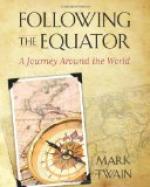Afternoon. Passing between Tasmania (formerly Van Diemen’s Land) and neighboring islands—islands whence the poor exiled Tasmanian savages used to gaze at their lost homeland and cry; and die of broken hearts. How glad I am that all these native races are dead and gone, or nearly so. The work was mercifully swift and horrible in some portions of Australia. As far as Tasmania is concerned, the extermination was complete: not a native is left. It was a strife of years, and decades of years. The Whites and the Blacks hunted each other, ambushed each other, butchered each other. The Blacks were not numerous. But they were wary, alert, cunning, and they knew their country well. They lasted a long time, few as they were, and inflicted much slaughter upon the Whites.
The Government wanted to save the Blacks from ultimate extermination, if possible. One of its schemes was to capture them and coop them up, on a neighboring island, under guard. Bodies of Whites volunteered for the hunt, for the pay was good—L5 for each Black captured and delivered, but the success achieved was not very satisfactory. The Black was naked, and his body was greased. It was hard to get a grip on him that would hold. The Whites moved about in armed bodies, and surprised little families of natives, and did make captures; but it was suspected that in these surprises half a dozen natives were killed to one caught—and that was not what the Government desired.
Another scheme was to drive the natives into a corner of the island and fence them in by a cordon of men placed in line across the country; but the natives managed to slip through, constantly, and continue their murders and arsons.
The governor warned these unlettered savages by printed proclamation that they must stay in the desolate region officially appointed for them! The proclamation was a dead letter; the savages could not read it. Afterward a picture-proclamation was issued. It was painted up on boards, and these were nailed to trees in the forest. Herewith is a photographic reproduction of this fashion-plate. Substantially it means:
1. The Governor wishes the Whites and the Blacks to love each other;
2. He loves his black subjects;
3. Blacks who kill Whites will be hanged;
4. Whites who kill Blacks will be hanged.
Upon its several schemes the Government spent L30,000 and employed the labors and ingenuities of several thousand Whites for a long time with failure as a result. Then, at last, a quarter of a century after the beginning of the troubles between the two races, the right man was found. No, he found himself. This was George Augustus Robinson, called in history “The Conciliator.” He was not educated, and not conspicuous in any way. He was a working bricklayer, in Hobart Town. But he must have been an amazing personality; a man worth traveling far to see. It may be his counterpart appears in history, but I do not know where to look for it.




